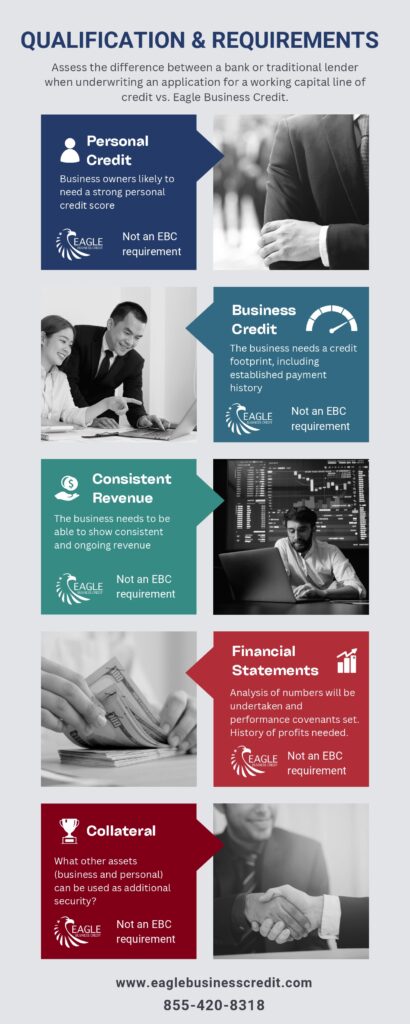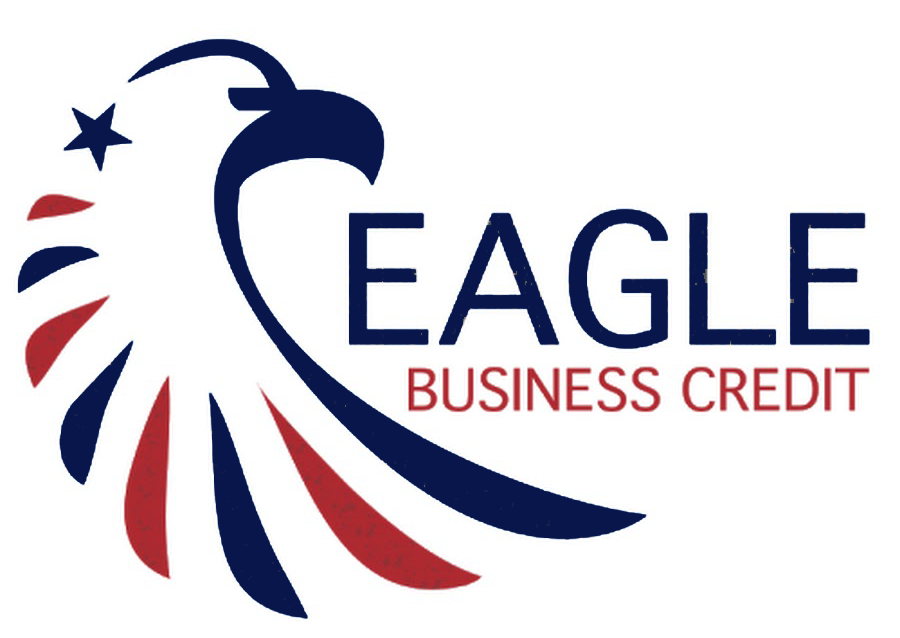Running a business often requires navigating the ebbs and flows of operational finances. To maintain smooth operations, access to working capital is essential, allowing businesses to handle daily expenses and manage cash flow efficiently. A working capital line of credit provides this kind of financial support, giving businesses the ability to cover short-term needs.
At Eagle Business Credit, we understand the importance of working capital and its role in your business’s growth and stability. Our funding solutions are designed to ensure that you have the money you need available to meet your obligations, from payroll to inventory purchases, irrespective of cash flow fluctuations. This type of financial arrangement can be particularly beneficial during periods where expenses might exceed revenue, such as off-seasons or while awaiting customer payments
Offering businesses the opportunity to tap into funds as needed without the rigidity of a term loan, a working capital line of credit from Eagle Business Credit empowers businesses to not only survive the unpredictability of market conditions but to thrive and scale with confidence.
Exploring Working Capital Lines of Credit
When managing the peaks and troughs of a business’s finances, a working capital line of credit is an indispensable tool for covering short-term operational needs. Here, we provide clarity on what it is and why it’s beneficial for businesses.
Definition and Purpose
Working capital is the lifeblood of a company, fueling daily operations and short-term obligations. A working capital line of credit is a flexible financing solution that ensures businesses have access to the capital they need to operate smoothly. Unlike fixed loans, this type of credit is revolving, allowing businesses to draw from it as needed. It’s specifically designed to finance ongoing operational expenses such as inventory, payroll, and rent, ensuring that a company can continue to flourish even during periods of variable cash flow.
Working Capital vs. Term Loans
Term loans and working capital lines of credit serve different purposes for a business. A term loan is typically used for long-term investments such as equipment or expansion, and it’s paid back over a set period with a predetermined repayment schedule. In contrast, a working capital loan or line of credit is short-term funding, used to manage companies’ daily expenses. While term loans provide a one-time lump sum of money, a business line of credit is akin to a reservoir of funds that companies can tap into whenever necessary, affording them the agility to handle short-term financial responsibilities or to capitalize on immediate opportunities.
Qualifications and Requirements
When considering applicants for a working capital line of credit, Eagle Business Credit focuses on different criteria than generally seen from a bank who concentrate on specific qualifications that indicate a company’s ability to manage and repay the financing such as business’s creditworthiness and financial health.

Creditworthiness and Credit Score
- Credit Scores: Banks typically look for a robust business credit score that reflects responsible credit management. A business’s credit score is a critical factor in their evaluation process.
- Personal Credit: Owners may also need to have a strong personal credit score, especially in newer or smaller businesses where personal and business finances are closely intertwined.
Revenue and Financial Health
Consistent Revenue: A consistent, ongoing revenue stream is crucial. Banks assess past and current revenues to ensure a business can meet the requirements of managing additional debt and don’t like to see low sales periods.
Financial Statements: Analyses of financial statements help gauge the overall financial health of a business. This review helps to understand if a company has the economic stability to support a working capital line of credit or term loan without posing undue risk. The review will also highlight any trends and help set performance covenants that the business will be accountable to.
Collateral: While not always required, collateral can play a role in securing a line of credit. It assures the lender that there are tangible assets backing the borrowed funds that can be leveraged in the event of a default.
At Eagle Business Credit, we approve our working capital line of credit applicants differently. Instead of the traditional methods shown above, we look at what the business does and who they sell to as more important. This makes far more sense as it is the customers of a company that generally provide the majority of the ongoing cash flow when they pay their invoices and gives a new start or growing business far more ability to qualify for financing.
The Cost of a Working Capital Line of Credit
Understanding the costs associated with a working capital line of credit is essential for businesses looking to manage their financial obligations effectively. The expenses mainly revolve around interest rates, various fees, and the repayment terms and conditions attached to the credit facility.
Interest Rates and Fees
Interest Rates:
- Typically vary from lender to lender
- Determined based on factors such as creditworthiness and market rates
- Penalty or default rates are common practice and can trigger from something as simple as a fall in revenue.
Fees may include:
- Origination Fee: A one-time fee charged when establishing the credit line
- Draw Fees: Charged each time funds are withdrawn and may vary depending on the type of disbursement taken
- Annual or monthly maintenance fees
Repayment Terms and Conditions
Repayment Terms:
- Short-term, often requiring daily, weekly, or monthly payments
- Revolving in nature, meaning you can withdraw and repay up to the credit limit
Conditions:
- Failure to adhere to terms may result in penalties
- Early repayment can sometimes reduce overall interest paid or even additional fees if minimum volume commitments have not been met.
In our experience at Eagle Business Credit, businesses must review the annual percentage rate (APR) to understand the true cost of borrowing, as it encompasses both interest rates and fees. We prioritize transparent terms and clear communication to ensure our clients fully understand the financial commitment of a working capital line of credit.
Strategic Uses and Management
Working capital lines of credit offer the agility to navigate through financial uncertainties and opportunities. They enable a business to manage operating expenses effectively and maintain liquidity without disrupting cash flow.
Cash Flow and Flexibility
Cash Flow: With a working capital line of credit, a business can tap into funds as needed to cover essential running costs such as inventory, payroll, and utilities. This ensures a steady cash flow is maintained, even during cycles when accounts receivable are delayed or sales are slower than usual.
- Flexibility: It grants the flexibility to use the funds for various short-term needs without the restrictions that often come with other types of business financing. Whether it’s for acquiring additional inventory to capitalize on bulk purchase discounts or handling unexpected rent increases, the revolving nature of these funds means a business can adapt quickly and effectively.
Balancing Current Assets and Liabilities
- Current Assets vs. Current Liabilities: The judicious use of a working capital line of credit aids in balancing current assets and current liabilities. Keeping accounts payable in check while ensuring timely access to cash is crucial for maintaining the fiscal health of a business.
- Liquidity: A working capital line of credit helps maintain liquidity, bridging cash flow gaps that could otherwise hinder daily operations. This approach allows operating expenses to be met punctually, which includes handling accounts receivable and payables proficiently.
By strategically managing working capital line of credit, we empower Eagle Business Credit to operate with confidence, meeting financial obligations head-on, while also pursuing opportunities for growth and stability.
Frequently Asked Questions
What are the advantages of a working capital line of credit over a traditional term loan?
A working capital line of credit offers flexibility that a traditional term loan cannot. It allows businesses to draw funds as needed up to a certain limit, making it an ideal solution for managing cash flow and daily operational costs.
How does one calculate the appropriate size for a working capital line of credit for a business?
The appropriate size for a working capital line of credit is calculated based on a business’s short-term liabilities and its average daily expenses. It’s essential to assess cash flow patterns comprehensively.
What are the typical interest rates associated with a working capital line of credit?
Interest rates for working capital lines of credit vary, often depending on the prime rate, financial health of the business, and creditworthiness. They’re typically lower than credit card rates but higher than traditional term loan rates due to their flexibility. Eagle Business Credit also offers discount rate rates based on the value of the invoice which many businesses like, particularly during times of interest rate uncertainty.
What are the common eligibility criteria and requirements for obtaining a working capital line of credit?
Eligibility for a working capital line of credit typically involves a review of credit history, business revenue, financial statements, and often a personal guarantee. Lenders assess the risk before granting credit. Eagle Business Credit places more importance on what the business does and who they sell to, often making qualification far quicker and easier.
What constitutes the four main components of working capital, and how do they impact a company’s financial health?
The four main components of working capital are inventory, accounts receivable, accounts payable, and cash. These elements collectively affect a company’s liquidity, operational efficiency, and its ability to meet short-term obligations.

